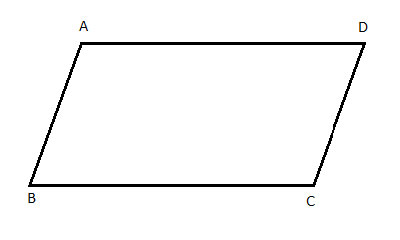A parallelogram is defined as a quadrilateral with two opposite pairs of sides are parallel. We have said (and proven) that parallelograms have four basic properties:
- The two pairs of opposite sides are of equal length
- The two pairs of opposite angles are congruent
- Two pairs of consecutive angles are supplementary
- And The diagonals bisect each other
We will now show that the converse is true - that if one of these properties holds, the quadrilateral is a parallelogram.
We will start with a fifth converse theorem - that if a quadrilateral has one pair of sides that is both parallel and equal in length it is a parallelogram.
Problem

In quadrilateral ABCD, AD||BC and AD=BC. Show that ABCD is a parallelogram
Strategy
To show that a quadrilateral is a parallelogram using the definition of a parallelogram, we need to show that both pairs of opposite sides are parallel. Here, we are already given the fact that one pair is parallel - AD||BC, so we will need to do so for the other pair - that is, show that AB||DC.
To show that two lines are parallel, we can use the converse of the Corresponding Angles Theorem, (that is, show that 2 corresponding angles are congruent) or the converse Alternate Interior Angles Theorem (show that the interior alternating angles or exterior alternating angles are congruent), whichever is easier.
But to show any such congruent angles, we will need to create some triangles, in order to use triangle congruency. It will be helpful to create these triangles in a way that makes use of known sides that are equal, so since we are told that AD=BC, we should probably make them sides in the triangles we create. So let's do that:

This creates 2 triangles with 2 equal sides - the diagonal BD is common to both, and AD=BC, as given.
We also know that AD||BC so ∠ADB ≅ ∠CBD as alternating interior angles formed by a transversal line (BD) intersecting two parallel lines (AD and BC). Then the two triangles ΔADB and ΔCBD are congruent, by the Side-Angle-Side postulate, and from this, we get that ∠BDC ≅ ∠DBA, as corresponding angles in congruent triangles, and now we can apply the converse Alternate Interior Angles Theorem to show that AB||DC.
Proof
(1) BD=BD //common side, the reflexive property of equality
(2) AD=BC // given
(3) AD||BC // given
(4) ∠ADB ≅ ∠CBD // (3), alternating interior angles formed by a transversal line
(5) ΔADB ≅ ΔCBD // Side-Angle-Side postulate
(6) ∠BDC ≅ ∠DBA // corresponding angles in congruent triangles, (CPCTC)
(7) AB||DC // converse Alternate Interior Angles Theorem
(8) ABCD is a parallelogram //Definition of a parallelogram - a quadrilateral with two pairs of opposite sides that are parallel to each other.
